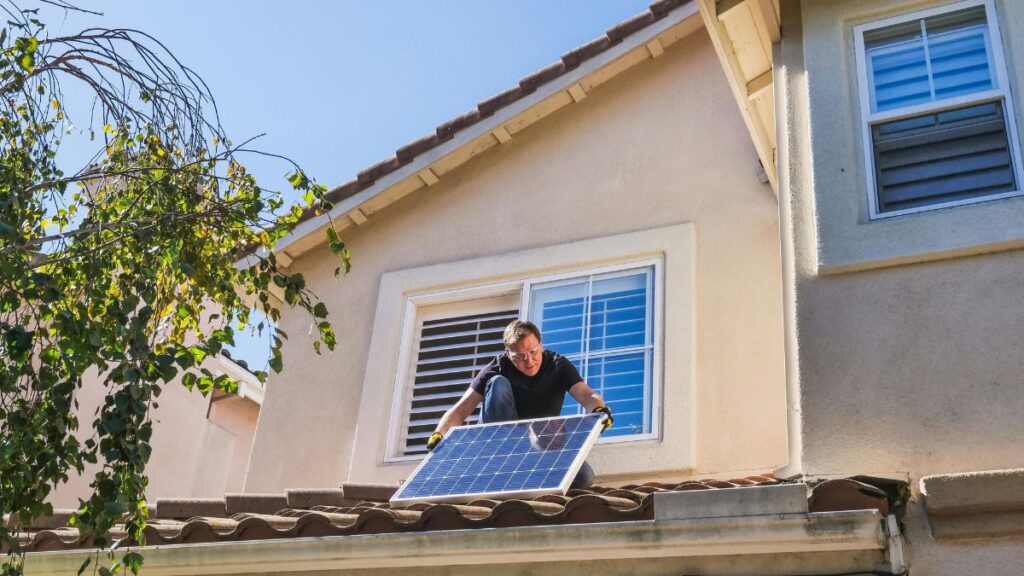Trying to decide between string inverters and microinverters for your solar setup? Think of it as choosing between a one-size-fits-all T-shirt or one perfectly tailored to you. String inverters are like having one big control center for all your solar panels.
Handy, right? But, what if one panel hits the shade? Well, it affects all the others. Microinverters, on the other hand, give each panel its little boss.
This means if one panel takes a break (hello, shade!), the others keep working hard. Curious about which one suits your solar needs? Keep reading to find out!
What Are String Inverters?
String inverters are the most established type of inverter and generally operate by connecting a ‘string’ of solar panels to a single centralized inverter. The DC power from these panels is pooled together and then converted into AC power.

Pros of String Inverters
String inverters come with a bunch of good points that make them a cool pick for many people.
Simplicity
String inverters are super easy to use. It’s like having just one remote control for all your TV stuff instead of one for each thing. All your solar panels are hooked up to this one inverter, and that’s it. You don’t have to worry about a lot of complicated stuff. It’s straightforward and not hard to figure out.
Proven Technology
String solar panel inverters aren’t anything new under the sun, believe it or not. They’ve been around the block a few times, which means people know pretty much what to expect from them. They’ve stood the test of time, getting tweaked and tuned over the years to work better and last longer.
If something goes sideways, chances are there’s someone who knows how to fix it without reinventing the wheel. Plus, you’ve got companies so contact Blue Raven Solar that stand behind their products, so you’re not out there all alone trying to make heads or tails of things.
Cons of String Inverters
Despite their advantages, string inverters aren’t perfect and come with their own set of headaches.
Shading Issues
Shading’s a real bummer for string inverters, you know? It’s like if one solar panel gets a bit of shade from a tree or something, the whole system takes a hit. Imagine you and your friends are in a tug-of-war team, and one person trips – it kind of slows everyone down, right? That’s what happens with this inverter technology.
Even a little bit of shade on just one panel can make the whole setup work less well. It’s not cool, especially if you’ve got trees or chimneys that play peek-a-boo with the sun.
Maintenance
When it comes to fixing stuff, string inverters can be a bit of a headache. Since you’ve got all your eggs in one basket, if your inverter decides to take a nap and not wake up, your whole solar power party comes to a halt.
It’s like your entire band stopping because the lead singer has a sore throat. And finding the problem isn’t always a cakewalk. Sometimes, it’s like playing a guessing game where you’re not sure if it’s the inverter or a panel that’s causing the fuss.
What Are Microinverters?
Microinverters are a newer innovation in solar technology. Instead of having one central inverter, each solar panel has its own small inverter attached directly to the panel.
Pros of Microinverters
Microinverters are super awesome for a bunch of reasons that’ll make you go, “Wow!”
Individual Panel Optimization
Each panel operates independently, so if one panel is shaded or underperforming, it doesn’t affect the others. It’s like having a team of players instead of one big blob making decisions for everyone.
This also means you can expand your system easily by adding individual panels, and it won’t affect the performance of your current setup.
System Expansion
It’s easier to add additional panels over time since each one operates independently. So, if you want to start small and grow your solar system slowly, microinverters make that a breeze.
Monitoring
Detailed monitoring of individual panel performance is possible.
Cons of Microinverters
While microinverters have their perks, they aren’t without their drawbacks.
Cost
These systems are generally more expensive due to the increased number of components. However, this cost can be offset by the potential for higher energy production and longer lifespan.
Maintenance
More components can mean more points of failure, although issues may only affect a single panel rather than the whole system. Additionally, since microinverters are attached to each panel, the potential for physical damage is higher than with a centralized inverter.
Comparing the Two
When choosing between string inverters and microinverters, consider the following aspects of your particular solar project:
Budget
If upfront costs are your primary concern, string inverters could be the way to go. However, if long-term savings and higher energy production are more important, microinverters may be worth the initial investment.
System Size
Larger systems can benefit from economies of scale with string inverters. On the other hand, microinverters are better suited for smaller systems where individual panel optimization and expansion may be desired.
Roof Shape and Shading
If your roof has complex shapes, varying angles, or partial shading, microinverters can maximize efficiency. String inverters may struggle in these situations, leading to decreased energy production.
Maintenance and Reliability
Think about long-term maintenance-microinverters may provide more redundancy. However, reliability can also depend on the quality of the products and installation.
System Expansion
Plan for the future. If you anticipate wanting to add more panels, microinverters offer more flexibility. String inverters may require rewiring and reconfiguration to expand the system.
Learn All About String Inverters
In the end, picking between string inverters and microinverters is like choosing between a big, one-size-fits-all hat and a bunch of tailor-made caps. If you’re watching your wallet, want something tried and true, and have a simple roof, maybe grab that big hat and go with a string inverter.
But if you’ve got a bit more coin, are cool with the latest tech, and have a funky roof or some shade playing tag, those tailor-made caps – or microinverters – might just be your jam. Either way, do your homework, think about what you really need, and you’ll make a solid choice for your solar setup.
Did you find this article helpful? Check out the rest of our blog.
